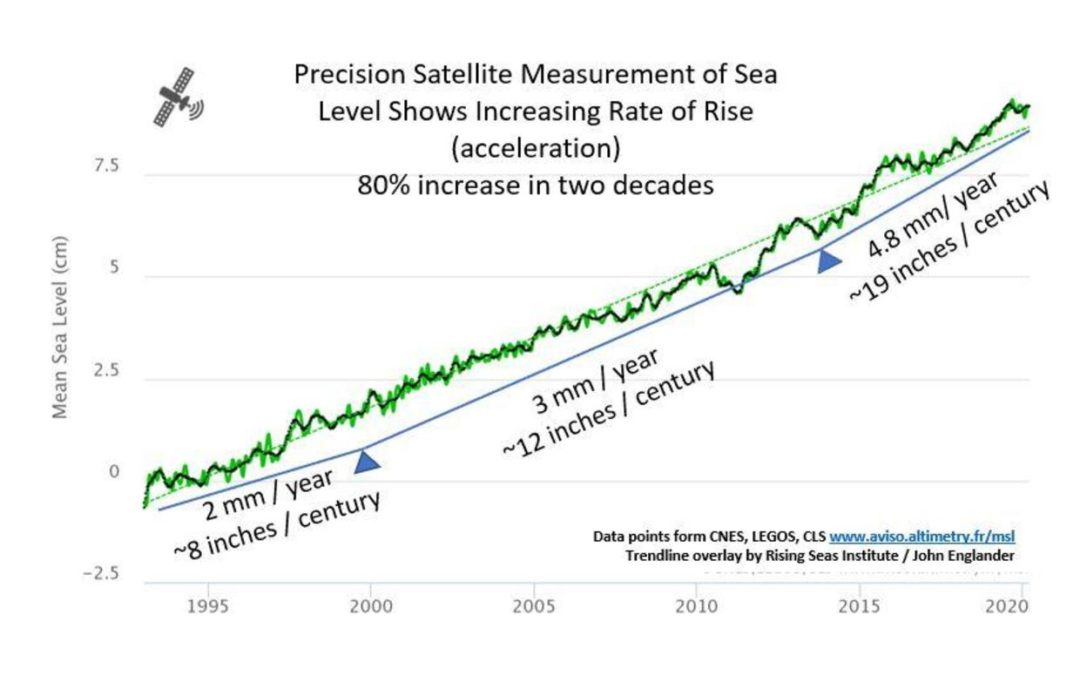SOURCE: CBS News, Cell Press, and Nature Communications
DATE: December 23, 2020
SNIP: Of the many threats from climate change, sea-level rise will most certainly be among the most impactful, making hundreds of thousands of square miles of coastline uninhabitable and potentially displacing over 100 million people worldwide by the end of the century. This threat is a top concern for national security experts because forced migration poses significant risks to international security and stability.
The magnitude of this threat depends heavily on how much the oceans rise in the coming decades. But because of the complex dynamics of massive ice sheets in Greenland and Antarctica, exact estimates remain elusive, ranging from just over a foot to several feet above current levels. That disparity is the difference between tens of millions of people forced from their homes or a much more unmanageable hundreds of millions displaced.
In the most recent report from the U.N.’s Intergovernmental Panel on Climate Change (IPCC AR5), the median sea-level rise projections by the end of the century range from 16 inches for a low-end warming scenario to 2 feet for a high-end scenario (compared to the average sea level from 1986-2005). The estimates also come with a large degree of uncertainty, which pushes the top bound of likely sea-level rise above 2 and a half feet.
The new paper, titled “Twenty-first century sea-level rise could exceed IPCC projections for strong-warming futures,” takes issue with that upper estimate, saying it is likely too low. The paper was published by a who’s who of the most well known glaciologists and sea-level rise experts, including Martin Siegert, Richard Alley, Eric Rignot, John Englander and Robert Corell.
John Englander is a co-author of the paper and author of the books “High Tide on Main Street” and the soon-to-be-released “Moving to Higher Ground: Rising Sea Level and the Path Forward.” He says this paper is a reaction to a “chorus of concern in the scientific community that the projections for rising sea level were understated.”
In a Zoom conversation with CBS News, Englander illustrated that sea-level rise contribution from Antarctica, by far Earth’s largest ice sheet, does not increase from a low-end warming scenario to a high-end warming scenario in the IPCC’s latest report — but in the real world it should. While the possibility of significantly higher sea-level rise due to Antarctica is mentioned in a footnote, it is by no means front and center. Englander explains that in a high-end warming scenario, obviously Antarctica’s ice melt should contribute more to sea-level rise than in a low-end warming scenario, but that is not reflected in the report.
Another paper published in Nature this week makes a similar case, focused on the evidence from Greenland. Employing the latest models used to inform the next IPCC report, the authors found that in a high-warming scenario Greenland may contribute an extra 3 inches to sea-level rise by the end of the century, when compared to the former version of models used by the IPCC. This extra sea-level rise is due to an additional 2 degrees Fahrenheit of warming projected by the new climate models in the Arctic.
A big concern of Englander’s for our future is the non-linear behavior of sea-level rise. In recent years the pace of sea-level rise has been accelerating. In the 1990s the oceans rose at about 2 millimeters per year. From 2000 to 2015 the average was 3.2 millimeters per year. But over the past few years the pace has quickened to 4.8 millimeters per year.
At the current pace, we can expect at least 15 more inches of sea-level rise by the year 2100. But, as has been the case for the past few decades, the pace of sea-level rise is expected to continue to increase for the foreseeable future. So, 15 inches is not only a lower bound, it is also extremely unlikely.
Adding confidence to the paper’s warning that IPCC projections for a strong warming scenario may be too low, is the evidence that sea-level rise has been running on the high end of IPCC projections for decades.
Historically speaking, simple math reveals that for every degree Fahrenheit the Earth warms, sea-level eventually rises by an astonishing 24 feet. Considering that Earth has already warmed 2 degrees Fahrenheit since the late 1800s, we know that substantial sea-level rise is already baked in, regardless of whether we stop global warming. Scientists just don’t know exactly how long it will take to see the rise or how fast it will occur. But using proxy records, glaciologists can see that as we emerged from the last Ice Age, sea level rose at remarkable rates — as fast as 15 feet per century at times.

